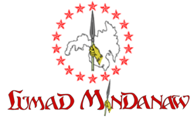Lumad Mindanao Peoples Federation
About Lumad Mindanao Peoples Federation (LMPF)
1979-1985 is considered to be the formative stage of LMPF. It was first incepted as Lumadnong Alyansa sa Mindanao alang sa Demokrasya or Lumad Alliance in Mindanao for Democracy (LUMAD-Mindanao). It is a multi-sectoral alliance composed (80% non-lumad and 20% lumad) of Lumad and non-lumads eg religious groups (bishops, priests, Moro, nuns, brothers, laywo/men), peasants, workers, youth, women, and the like chaired by a lumad (Subanen) human rights lawyer, Atty. Fausto Lingating of Pagadian City. The Alliance’s purpose was to project the plight and aspiration of the Lumad Peoples in Mindanao in the face of the Marcos dictatorial rule that widely violates peoples’ human rights including that of indigenous peoples.
In the eve of the so-called EDSA Revolution/People’s Power in 1986 that toppled down the Marcos hegemony, the Lumad group asserted to separate and form their own “pure” Lumad organization. At first the dominant members particularly the non-lumad opposed the idea considering that Lumad lack technical sophistications to handle and manage its own affair. But the Lumad insisted and in June 1986, the Lumad Mindanaw/LM was inaugurated. LM served as the umbrella organization of the Lumad Peoples’ in Mindanao. On this very occasion, the delegates of the assembly adopted the Bisayan word “Katawhang Lumad” (Lumad Peoples or Lumad, for brevity) as the collective identity of the un-Islamized original peoples of Mindanao. Following year in 1987 during the 5th session of the United Nations Working Group on Indigenous Population/UNWGIP, Genève, the word Katawhang Lumad or Lumad Peoples entered into the UN lexicon as identity of the un-Islamized peoples in Mindanao, Philippines. And 11 years later in September 1998 LMPF was accredited by the Economic and Social Council-ECOSOC of the United Nations as nongovernmental organization pursuant to UNCHR res. 1995/35 and 2001/58. In 2007, Wikipedia recognize LMPF as its No. 1 Reference when it comes to “Lumad peoples”.
In September 1994 during the LM Special Assembly held in a Bla-an Community in Mul’bulen, Sarangani Province, the Assembly owing to the new direction of the LM of revitalizing the indigenous political structure as expression of self-determination approved to affix “Peoples’ Federation” to Lumad Mindanaw making it Lumad Mindanaw Peoples Federation/LMPF. Currently LMPF is an independent organization-cum-movement that stands for the inherent, inalienable and collective rights to land (ancestral domain/territory and natural resources) and self-determination (tribal governance through indigenous people’s structure). Such rights are recognized, protected and promoted by national and international laws and standards. Being an independent organization means LMPF neither sides or subservient to the state or to any non-state stakeholders eg revolutionary groups.
Members
Leaders: Governing Council
Gukom Joe Macarial-Subanen
Guhom Sonny Latao-Subanen
Datu Balitēngteng Antonio-Higaunon
Datu Untung Fidel Bisoy-Higaunon
Datu Mandagase Venancio Rico-Agusan Manobo
Datu Tagulambong-Banuwaon
Datu Emil Hide-Mamanuwa
Datu Rico Maca-Surigao Manobo
Datu Edwin Omo-Ata Manobo
Datu Art Davao-Talaingod
Datu Ambungan Lolito Manlubatan-Agusan Manobo
Fulong Gospel Moranos; Datu Crispin Simfal-Taboli
Timuay Maestro Sayot Masandil-Teduray
Timuey Elencio D Tipunan-Erumanen ne Menuvù
Edtami P Mansayagan-Erumanen ne Menuvù/United Nations HRC EMRIP Mandate Holder
Matikadung Sarx Lanos Sr.-Mansaka and Pependayan Jimid Mansayagan-interim Chairman.
Objectives
References
Fr. Albert E Alejo, SJ
Ateneo de Zamboanga University
Zamboanga City
Email: paringbert@yahoo.com
Phone: 09177045474
Rep. Nancy A Catamco
Cotabato District II, Representative
Chairperson, House Committee on National Minorities
House of Representatives
Quezon City
Edtami Mansayagan
Mandate Holder
Expert Mechanism on the Rights of Indigenous Peoples/EMRIP
Office of the High Commission on Human Rights
Human Rights Council
Mobilephone: 09177196367
Email: pulasag@yahoo.com
LMPF have given up all hopes dealing with NCIP in relation to IP plight and aspiration. This government agency for indigenous peoples is hard to deal with when it comes to defending the rights IPs against companies in the ancestral domain especially when it is own by politicians with strong connection with Malacañan. However, the current weaknesses of NCIP cannot be construed as weaknesses of RA 8371 or IPRA, the law that establishes NCIP.
Who are the Lumad People?
The Lumad is a term being used to denote a group of indigenous peoples of the southern Philippines. It is a Cebuano term meaning "native" or "indigenous". The term is short for Katawhang Lumad (literally "indigenous peoples"), the autonym officially adopted by the delegates of the Lumad Mindanaw Peoples Federation (LMPF) founding assembly on 26 June 1986 at the Guadalupe Formation Center, Balindog, Kidapawan, Cotabato, Philippines. It is the self-ascription and collective identity of the non-Islamized indigenous peoples of Mindanao.
There are 18 Lumad ethnolinguistic groups namely, Atta, Bagobo, Banwaon, B’laan, Bukidnon, Dibabawon, Higaonon, Mamanwa, Mandaya, Manguwangan, Manobo, Mansaka, Subanon, Tagakaolo, Tasaday, Tboli, Teduray, and Ubo.
- source: verbatim: https://intercontinentalcry.org
Article Contributors
- Jimid P. Mansayagan - chairperson of LUMAD MINDANAW PEOPLES FEDERATION/LMPF
